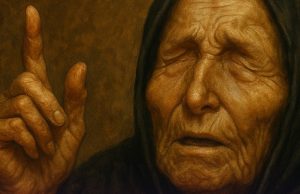
Since the beginning of human consciousness, we’ve questioned what happens when life ends. When the heart beats for the last time, do we cease to exist—or is there something beyond, waiting in the unknown?
Across the ages, many have claimed to catch a glimpse of what lies beyond death. Some describe it as an afterlife, others see it as a separate realm, while skeptics dismiss it as the brain’s final surge of activity before shutting down.
Yet, now and then, a story emerges that defies all conventional explanations. This is one of those stories—the extraordinary experience of 33-year-old Brianna Lafferty from Colorado, who was clinically dead for eight minutes, yet insists she was more alive than ever.
Who Is Brianna Lafferty?
Brianna has long been familiar with physical adversity. She was diagnosed years ago with myoclonus dystonia, a rare neurological condition that causes sudden, uncontrollable muscle contractions. Simple actions like writing, walking, or standing still can become battles against a body that moves on its own.
Though the disorder was challenging, Brianna had found ways to cope and live with it—until the day her body completely shut down.
Without warning, her heart stopped. Medical professionals did everything they could, but there was no pulse, no breathing, and no signs of brain activity. For eight minutes, according to modern medicine, Brianna was gone.
But she tells a different story—one where she didn’t leave or lose consciousness at all. In her words, she remained fully aware the entire time.
The Moment of Departure
Brianna recalls the experience of leaving her body as surprisingly peaceful. There was no sense of being yanked out or pushed away—it was more like quietly slipping off a heavy coat she hadn’t realized she was wearing.
From above, she observed the scene below. But her lifeless body and the commotion in the room didn’t hold her attention. Almost instantly, she felt drawn toward something else—a shift into what she describes as “a space without time.”
In this realm, there were no clocks, no ticking moments—yet she remained completely aware. She says she felt more truly herself than ever before, as though the “Brianna” she had been on Earth was only a small part of a much greater whole.
There was no pain, no fear, and no need to breathe—only a calm, steady sense of presence.
A Landscape Shaped by Thought
One of the most fascinating parts of Brianna’s story is how the environment seemed to respond to her thoughts. At first, she noticed that whatever she focused on began to form around her—but slowly, as though the universe there took its time answering her.
If a negative thought emerged, she had space to shift it into something positive before it fully materialized. She found herself deliberately choosing peaceful, loving images, knowing they would eventually shape her surroundings.
To her, this felt like proof that even beyond the boundaries of life, the mind—or consciousness—has creative power.
Eight Minutes or Months?
Back on Earth, the clock recorded her absence at exactly eight minutes. But in that other space, Brianna says it felt like months had passed. She had time to explore, reflect, and even interact with what she calls “familiar presences.”
She doesn’t claim these presences were human in the way we understand humanity. They seemed to be beings of awareness, not flesh, radiating a sense of unconditional acceptance.
And somewhere within this vast stillness, she says she sensed a greater presence—something wise, loving, and infinitely patient. There was no “voice,” yet its guidance was unmistakable.
Read more: The Butterfly Effect Is Real—But Science Says It Works Differently Than You Think
The Numbers Behind Reality
Among the stranger revelations Brianna brought back was her conviction that the universe is fundamentally made of numbers. Not just in the way mathematicians use equations to describe physics, but as if reality itself is constructed from numerical patterns—a kind of cosmic code.
This isn’t an entirely new concept. Ancient Greek philosopher Pythagoras believed numbers formed the building blocks of everything. Modern physicists sometimes speak about the “mathematical universe hypothesis,” which suggests that the physical world is, at its core, a mathematical structure.
Brianna didn’t arrive at this idea through study—she says she simply knew it while she was there.
The Return to Life
Coming back wasn’t graceful. Brianna awoke to a damaged body. She had to relearn how to walk and speak. Her pituitary gland—an important hormone regulator—had been harmed, leading to health complications that required experimental brain surgery.
She admits she is afraid of going through another near-death event. But she’s also grateful for the perspective it gave her.
Today, she describes her purpose as “living deliberately,” even if she doesn’t have a step-by-step mission plan. She is less afraid of death, more appreciative of life, and more aware of how her thoughts shape her experience.
What Science Says About Near-Death Experiences
While Brianna’s story is deeply personal, scientists have long tried to explain near-death experiences (NDEs) in purely biological terms.
Some neurologists suggest NDEs are caused by anoxia—a lack of oxygen to the brain—which can trigger hallucinations and distort the sense of time. Others point to a flood of neurotransmitters like endorphins and dopamine, which could create sensations of euphoria and visions of light.
Researchers have also studied the right temporoparietal cortex, an area of the brain responsible for processing information about the body in space. When this region malfunctions—whether through trauma, seizure, or oxygen deprivation—it can produce the feeling of floating outside the body or moving through a tunnel.
From this perspective, NDEs aren’t windows into another world, but the brain’s final protective illusions.
A Mystery Across Cultures
Still, what makes NDEs intriguing is how consistent they are across different cultures and time periods.
Ancient Egyptian texts describe journeys into other realms after death. Tibetan Buddhism teaches about the “bardo,” a transitional state between death and rebirth. In some Indigenous traditions, people speak of traveling across a bridge or river to meet ancestors.
While the imagery varies, the themes—light, peace, familiar presences—show up again and again.
Even among modern survivors, similarities emerge:
A feeling of leaving the body
A perception of moving through darkness toward light
Encounters with guiding beings
A review of one’s life
A decision or command to return
Brianna’s account fits neatly within these patterns, yet has its own unique twists—like the concept of the universe being made of numbers.
Researchers have also studied the right temporoparietal cortex, an area of the brain responsible for processing information about the body in space. When this region malfunctions—whether through trauma, seizure, or oxygen deprivation—it can produce the feeling of floating outside the body or moving through a tunnel.
From this perspective, NDEs aren’t windows into another world, but the brain’s final protective illusions.
A Mystery Across Cultures
Still, what makes NDEs intriguing is how consistent they are across different cultures and time periods.
Ancient Egyptian texts describe journeys into other realms after death. Tibetan Buddhism teaches about the “bardo,” a transitional state between death and rebirth. In some Indigenous traditions, people speak of traveling across a bridge or river to meet ancestors.
While the imagery varies, the themes—light, peace, familiar presences—show up again and again.
Even among modern survivors, similarities emerge:
A feeling of leaving the body
A perception of moving through darkness toward light
Encounters with guiding beings
A review of one’s life
A decision or command to return
Brianna’s account fits neatly within these patterns, yet has its own unique twists—like the concept of the universe being made of numbers.















